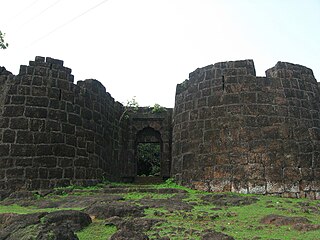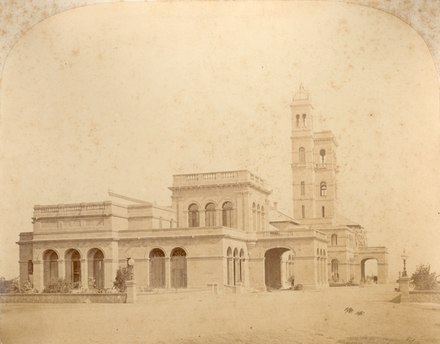
Malabar Hill, is a hillock and upmarket VIP residential neighbourhood in South Mumbai, Maharashtra, India. Malabar Hill is the most exclusive residential area in Mumbai, home to several business tycoons and film personalities. Notable residents include Adi Godrej, the Birla family, Shashi Ruia & family, Pallonji Mistry, Mahesh Jethmalani, the Jindal family, the Petit family, the Thakkar family and the Lal family etc.

Bombay State was a large Indian state created at the time of India's Independence, with other regions being added to it in the succeeding years. Bombay Presidency was merged with the princely states of the Baroda, Western India and Gujarat and Deccan States (which included parts of the present-day Indian states of Maharashtra and Karnataka.

Mahabaleshwar is a small town and a municipal council in Satara district in the Indian state of Maharashtra. It is a hill station located in the Sahyadri mountain range. With one of the few evergreen forests of India, it served as the summer capital of Bombay province during the British Raj.

Satara is a city located in the Satara District of Maharashtra state of India, near the confluence of the river Krishna and its tributary, the Venna. The city was established in the 16th century and was the seat of the Raja of Satara, Chhatrapati Shahu. It is the headquarters of Satara Tahsil, as well as the Satara District. The city gets its name from the seven forts (Sat-Tara) which are near the city.

The Raj Bhavan, formerly known during British India as the Bangalore Residency, the Mysore State Residency, or, simply, the Residency, is the official residence of the Governor of Karnataka. It is located in the capital city of Bangalore, Karnataka. During Mysore Kingdom, the building was home to the Resident of the British Agency that was in subsidiary alliance with the Kingdom of Mysore.
Raj Bhavan is the official residence of the Governor of Maharashtra. It is located in the capital city of Mumbai, Maharashtra on Malabar Hill. The Raj Bhavan is located in 50 acres (200,000 m2) of sylvan surroundings, surrounded on three sides by the sea. The estate has several heritage bungalows, trees, large lawns and a beach.

Vasai, historically known as Bassein or Baçaim, is a historical suburban town in the Palghar district of Maharashtra state in the Konkan division in India. It forms a part of Vasai-Virar city. Vasai was in the Thane district prior to 2014.

Panchgani also called Paachgani is a famous hill station and municipal council in Satara district in Maharashtra, India. It is renowned for the many premier residential educational institutions, which have produced notable lawyers.

Elphinstone College is an institution of higher education affiliated to the University of Mumbai. Established in 1856, it is one of the oldest colleges of the University of Mumbai. It is reputed for producing luminaries like Bal Gangadhar Tilak, Bhim Rao Ambedkar, Virchand Gandhi, Badruddin Tyabji, Pherozshah Mehta, Kashinath Trimbak Telang, Jamsetji Tata and for illustrious professors that includes Dadabhai Naoroji. It is further observed for having played a key role in spread of Western education in the Bombay Presidency.
Pune is a district in the state of Maharashtra, India. Pune City Central is the District Headquarters. The district's population was 9,426,959 in the 2011 census, the fourth-most-populous of India's 640 districts. Its urban population is 58.08 percent of its total population; the population of the Pune urban area is over five million.
The Haffkine Institute for Training, Research and Testing is located in Parel in Mumbai (Bombay), India. It was established on 10 January 1899 by Dr. Waldemar Mordecai Haffkine, as a bacteriology research centre called the "Plague Research Laboratory". It now offers various basic and applied bio-medical science services. The Institute opened a museum on its premises in March 2014 to showcase Haffkine's research and developments in microbiology and chart the history of the institute. The Institute received ISO 9001:2008 certification in 2012.
Bombay Castle is one of the oldest defensive structures built in the city of Mumbai. The current castle is a structure built by the British on the site of the Manor House built by a Portuguese nobleman Garcia de Orta. Orta had leased the island of Bombay from the King of Portugal between 1554 and 1570.
Raj Bhavan is the official residence of the Governor of Kerala. It is located in the capital city of Thiruvananthapuram, Kerala. Built in 1829 as Palace Guest house of Travancore Government Guest, this heritage structure hosts the present governor of Kerala is Justice (Retd) P Sathasivam.
Raj Bhavan of Nagpur is the Second residence of the Governor of Maharashtra, It is located in the Second Capital city of the state Maharashtra: Nagpur.

Maharashtra has the largest economy in India. It is third-most urbanised state with urban population of 45% of whole population. Each year, the Government of Maharashtra publishes the Economic Survey of Maharashtra to be tabled in the budget session of the State. Although highly industrialized, agriculture continues to be the main occupation in many regions the state. Mumbai, the capital of Maharashtra and also the financial capital of India houses the headquarters of almost all major banks, financial institutions, insurance companies and mutual funds. India's largest stock exchange Bombay Stock Exchange, oldest in Asia, is located in the city. More than 41% of the S&P CNX 500 conglomerates have corporate offices in Maharashtra. After successes in the information technology in the neighbouring states, Maharashtra has set up software parks in Pune, Mumbai, Navi Mumbai, Nagpur and Nashik, Aurangabad and Latur. Maharashtra is the second largest exporter of software with annual exports over ₹80,000 crores and accounts for more than 30 per cent of the country's software exports, with over 1,200 software units based in the state. Maharashtra ranks first nationwide in coal-based thermal electricity as well as nuclear electricity generation with national market shares of over 13% and 17% respectively. Maharashtra is also introducing Jatropha cultivation and has started a project for the identification of suitable sites for Jatropha plantations. Ralegaon Siddhi is a village in Ahmednagar District that is considered a model of environmental conservation.

Maharashtra attracts tourists from different states and foreign countries.It was the second most visited Indian state by foreigners and fourth most visited state by domestic tourists in the country in 2014. Aurangabad is the tourism capital of Maharashtra. Major urban cities include : Mumbai, Pune, Nashik, Aurangabad and Nagpur.
Raj Bhavan of Mahabaleshwar is the Summer residence of the Governor of Maharashtra, It is located in the city of Mahabaleshwar, Maharashtra.

The Battle of Koregaon was fought on 1 January 1818 between the British East India Company and the Peshwa faction of the Maratha Confederacy, at Koregaon Bhima.

Bankot is a town in Maharashtra, India. It became part of the Bombay Presidency in 1756.

Old Mahabaleshwar is a historical place and a village in Mahabaleshwar, Satara district in the Indian state of Maharashtra. It is a hill station located in the Western Ghats range.Old Mahabaleshwar is also known as "Kshetra Mahabaleshwar". Old Mahabaleshwar is about 6 km from Mahabaleshwar. This holy and sacred place has 3 temples: Panchganga temple, Mahabaleshwar temple and Krishna temple.

















